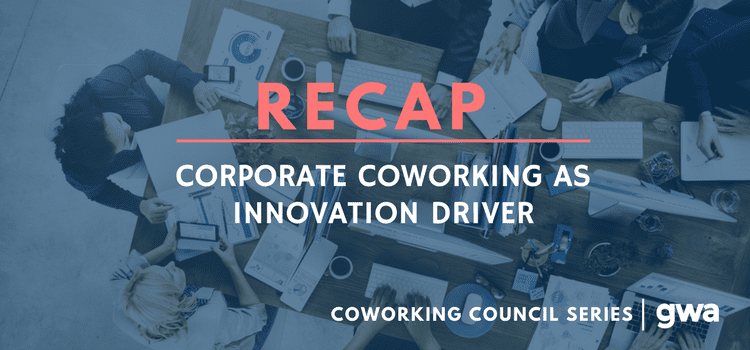As part of the second webinar of Global Workspace Association’s member-exclusive webinar series, Dr. Gabor Nagy, Research Program Manager, discussed the concept of corporate coworking and how it is developing and providing new opportunities for coworking businesses.
In contrast to commercial coworking spaces, which give public access to their space in return for either a fee or other potential profits, corporate coworking spaces generally extend invitations to select internal and external individuals to work in their spaces. Although the model is different, Nagy defined a number of ways general coworking principles are helping and shaping the world of corporate business.
Corporate Setting, Startup Mentality
In order to continue to grow, companies need to have their norms challenged. Coworking spaces in a corporate setting, Dr. Nagy explained, result in companies being disrupted in their ways of thinking and doing in order to create things that will, in turn, disrupt their industries. This disruption is the core of innovation: it pushes people out of the status quo and into uncharted territory.
Dr. Nagy said corporate coworking is, “Corporations creating coworking like spaces within their organizations that are temporary in nature, involve people internally and externally, experimental in nature, and usually have a larger agenda of innovation or business transformation.”
Generally, this combination of internal and external employees and company goals and innovation is accomplished by creating coworking spaces that provide a location inside the corporation for a startup company to incubate. Then, the company sends a portion of its employees to also work in this location, which has been designed for maximum interactive and collaborative opportunities. The result is that the corporate employees are able to absorb the risk-taking, innovative mentality common to startups, a shift which often leads to more creative ideas, better company culture, and increased efficiency. The partnership pushes corporate employees to explore, just like the startup, and look beyond the company’s traditional products or services.
The Nuts and Bolts of Corporate Coworking
Most corporate coworking teams are in the space for 6 to 9 months, as projects will finish or startups in the space will grow beyond the space’s ability. Instead of startups, corporate employees may find themselves alongside academics, freelancers, entrepreneurs, and researchers.
One important part of the corporate coworking model is a community manager, Nagy explained. While they rarely hold the title of “community manager,” they do mirror their commercial coworking counterparts in filling the critical role of maintaining the culture space, encouraging and drawing out the best in people, arbitrating conflicts, planning and hosting events and curating the community.
Community curation (hiring etc.) for corporate coworking spaces often looks less like evaluating a resume and more like having an employee work with the team on a trial basis and see how that person fits into the team. This difference reflects the importance of community within the coworking space. The importance of culture in these experimental spaces far outweighs strategy, Nagy said.
Designing Corporate Coworking Spaces
Corporate coworking spaces have to look different from regular corporate locations. They tend to be more informal, with a flexible, easily reconfigurable design. Reconfiguration is an important component for coworking in general, but specifically corporate coworking since startups and possibly corporate teams will only be in the space temporarily before startups outgrow the space and corporate employees take their new mentality back to the rest of the corporate setting.
Other needs for corporate coworking spaces also reflect general coworking space needs, including centralized amenities, natural light, and user-customizable features like dry erase walls. The versatility and relaxed atmosphere of well-designed coworking spaces makes them popular both for outside client meetings and for hosting internal or external events that attract more people to the space and increase networking opportunities
Measuring Performance
Although some companies try to measure the success of their spaces via hard metrics, Nagy said that soft metrics tend to work better. A common soft metric is questionnaires, which gather data on results such as: creative idea flow, social quality, friendship and collaboration opportunities, engagement, and learning experiences.
Nagy also remarked that these types of surveys garner an unheard-of 92 percent satisfaction rate.
There are also a number of unexpected benefits of corporate coworking spaces. These spaces increase social capital, providing many opportunities for networking both across and beyond the corporate setting. Many corporate employees benefit from the high-energy environment created by the presence of startups and entrepreneurs. The spaces also increase collaboration—even among traditionally-solitary professionals, such as software engineers. Corporations also generally experience a decrease in operational costs while simultaneously experiencing a 30–40 percent decrease in production time.
Issues to Consider
Nagy defined several potential concerns and pitfalls for corporate coworking spaces:
- Spaces that look just like the corporation’s regular setting are not effective in altering culture or mindset.
- Employees need to maintain a process of constant trial-and-error style learning where they can take risks, make mistakes, and improve. This attitude must transfer with them back into corporate culture.
- Coworking spaces are cyclical, which means companies need to plan on teams not staying permanently.
- The atmosphere of the coworking space tends to be set by the first group to work there—meaning that group must be carefully chosen. This includes choosing people who work well together as well as choosing a diverse group in order to maximize the resources they can draw upon.
Accessing the Webinar
For Dr. Nagy’s full discussion of how coworking is infiltrating corporate America as well as access to other past and future webinars, click here to sign up as a member of the Global Workspace Association.




